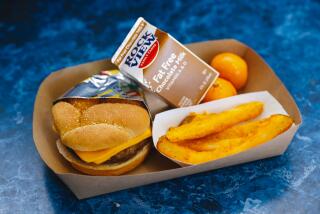For kids, more ‘go,’ fewer ‘whoa’ foods
- Share via
Children can indeed learn to eat smart and move more. And they do so, a new study finds, if their parents give them access to healthy food, encourage regular physical activity and set a good example for these habits themselves.
The Dietary Intervention Study in Children is the first study to test the safety and efficacy of a low-fat regimen on growth and development in children with elevated blood cholesterol, a key risk factor for premature heart disease.
When the study began, fatty snacks, desserts and pizza accounted for about a third of the daily calories consumed by the 663 participants, ages 8 to 10, as they do for most children today.
All participants were encouraged to daily get 60 minutes of physical activity. Half the children were then randomly assigned to a control group that received standard educational material on heart-healthy eating. The other half -- the intervention group -- enrolled in a yearlong, intensive program that included group meetings, individual sessions with registered dietitians, behavioral training and advice about boosting daily physical activity. These youngsters and their families received a guide that categorized food into three groups:
* “Go” foods that are nutrient rich and have little saturated fat, trans fat or cholesterol, such as fruits and vegetables without sauces or butter; whole grains; lean meat and poultry without the skin; egg whites; beans and nonfat or 1% dairy products; water and diet soda.
* “Slow” foods that are higher in fat and cholesterol, including Canadian bacon, lean ground beef, low-fat salad dressings and mayonnaise, 2% milk and 100% fruit juice, sports drinks and dried fruit.
* “Whoa” foods that should be eaten “once in a while” because they are calorie-dense or high in unhealthy fat. Examples include French fries, fruit in heavy syrup, fatty cuts of meat, chicken with the skin, whole eggs, cookies, cake, buttered popcorn, whole milk and regular soda.
Not only did the lower-calorie, low-fat regimen have no adverse effects on growth or development, but the study found that children learned healthy habits that lasted. Three years after the study began, kids in the intervention group consumed 67% of their calories from heart-healthy “go” foods, compared with 57% for the control group.
The results show that “families can learn to enjoy healthy foods and to be selective about their food choices” if they have “the right tools to help them make positive lifestyle changes,” said Elizabeth G. Nabel, director of the National Heart, Lung and Blood Institute, which funded the study.
To provide those tools, the National Institutes of Health last week launched the We Can! program to help reduce childhood obesity, increase physical activity and cut sedentary behavior.
Here are some suggestions:
* Help kids reach for “go” foods.
* Get youngsters moving. Children are more likely to be active -- and stay active -- if you do physical activities with them.
* Fists are for food. Serving sizes are usually too large for most kids, so use your child’s fist as a portion size for food.
* Quench thirst with water or nonfat milk, which is loaded with bone-building calcium.
* Serve dessert, but make it fruit. The study found that even children who otherwise improved their eating habits fell short on fruit.
* Make fruit part of each meal. Linda Van Horn, professor of preventive medicine at Northwestern University and lead author of the study, says, “Hungry kids will eat whatever is there, even the healthy stuff.”
The study appears in the journal Pediatrics. For more information call (866) 359-3226 or go to www.nhlbi.nih.gov/health/public/heart/obesity/wecan/index.htm.





